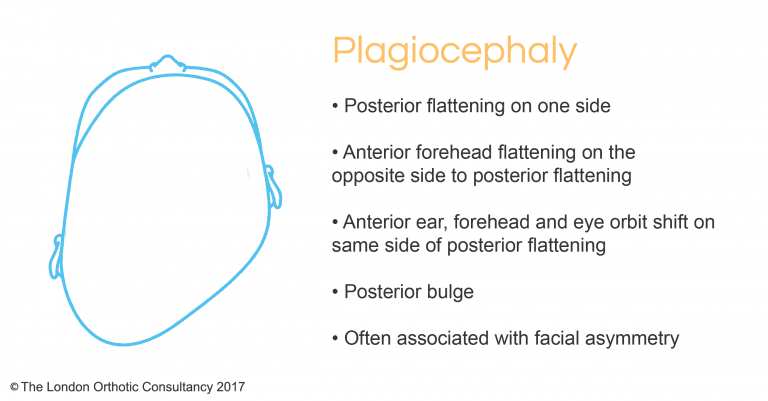Plagiocephaly
Plagiocephaly
What is Plagiocephaly /Baby Flat Head Syndrome
Positional Plagiocephaly is a condition that affects the skull, making the back or side of a baby’s head appear flattened. It may also involve bulging of the forehead, fullness of the cheek and ear misalignment on the same side as the flattening.
There are two types of the condition – Deformational – where the condition is caused by the birth process itself – and Positional – where it occurs post birth. Positional Plagiocephaly is more common.
Under the broad heading Positional Plagiocephaly there are three main types of asymmetrical head shape associated with the condition:
A baby’s skull is made up of several ‘plates’ of bones which at birth are not tightly joined together. They are soft enough to be molded by outside forces; this means their shape can be altered by pressure, just lying or sitting in the same position against a firm surface can cause flattening usually at the back of a baby’s head.
If you are concerned about the shape of your baby’s head, help and advice is at hand. You can get immediate and free advice from one of our experienced clinicians with our clinical plagiocephaly diagnosis form.
Plagiocephaly Head Shape

Baby Head Shapes
There are three main types of head shape that are associated with Baby Flat Head Syndrome.
Plagiocephaly, Brachycephaly, and Scaphocephaly.
.webp?width=768&name=baby-flat-768x259%20(1).webp)
If you think your baby does have some sort of flat or misshaped head and you are concerned you can quickly and easily get our clinical opinion for free with our Baby Flat Head Syndrome diagnosis form.
Treatment Options
If your baby has a mild form of Plagiocephaly, Brachycephaly or Scaphocephaly repositioning should be sufficient to help naturally resolve the issue. If your baby has moderate or severe forms of any of these head shapes helmet therapy with the LOCband is proven to be very effective at normalising head shape.
We have successfully treated babies up to the age of 16 months for positional plagiocephaly.
There have been exceptional cases where a baby’s fontanelles have not fused yet by the age of 18 months, where we have achieved successful, but less-marked, results with cranial remoulding therapy.
Brachycephaly Head Shape
Brachycephaly, derived from the Greek, means short head, the shape of the skull is shorter than average. A brachycephalic skull is flat in the rear. The crown of the head towards the back is often high, the baby’s face may be wide and the ears can also protrude.
Sometimes brachycephaly is a congenital condition, which means it exists at or before birth. According to the National Institute of Health (part of the USA’s Department of Health), brachycephaly occurs when the front bone and side bones join together before the skull is fully developed.
Brachycephaly that is not the result of a congenital condition is frequently position-related. This is by far the most common type of brachycephaly. Often acquired brachycephaly can be seen in children who have also been diagnosed with plagiocephaly. The risks for developing the acquired form of brachycephaly include all of the observed risk factors for plagiocephaly, as well as carrying low in the pelvis during pregnancy, very large birth size and breech birth.
There are two types of brachycephaly:
- Asymmetrical deformational bracyhcephaly (ADB)*
- Symmetrical deformational brachycephaly (SDB)
*ADB is also referred to as plagiocephaly with brachycephaly, or brachycephaly with plagiocephaly.
Contact Us
Please get in touch either by phone or by email and we will be back in touch with you as soon as possible, or fill in the form with your contact details and send it through to our clinical team.
Clinic and Shop Address:
5 - 7, Church Hill Road, East Barnet,
Herts, EN4 8SY
Opening Times:
Monday - Friday 09:30 - 17:00 &
Saturday 10:00 - 14:00
 020 8364 8800
020 8364 8800
 info@prestigehealthcare.co.uk
info@prestigehealthcare.co.uk

